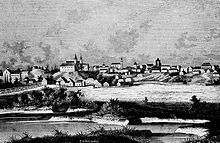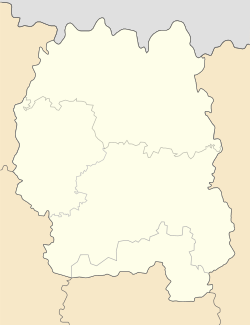Ovruch
Ovruch
Овруч | |
|---|---|
 St. Basil Church | |
| Coordinates: 51°19′28″N 28°48′29″E / 51.32444°N 28.80806°E | |
| Country | |
| Oblast | Zhytomyr Oblast |
| Raion | Korosten Raion |
| Hromada | Ovruch urban hromada |
| Founded | 946 |
| City rights | 1641 |
| Area | |
| • Total | 9 km2 (3 sq mi) |
| Elevation | 149 m (489 ft) |
| Population (2022) | |
| • Total | 15,250 |
| • Density | 1,700/km2 (4,400/sq mi) |
| Postal code | 11100 |
| Area code | +380 4148 |
| Website | Official website |
 | |
Ovruch (Ukrainian: Овруч) is a city in Korosten Raion, Zhytomyr Oblast, northern Ukraine. Until 2020, it was the administrative center of the former Ovruch Raion, until it was merged into Korosten Raion. It has a population of approximately 15,250 (2022 estimate),[1] and is home to the Ovruch air base.
Name
In addition to the Ukrainian Овруч (Ovruch), in other languages the name of the city is Polish: Owrucz and Yiddish: אוורוטש.
History

Ovruch originated as an important town of Kievan Rus', first mentioned as Vruchiy in 977. Later after the sack of Iskorosten it became the capital city of Drevlian.[2] Saint Hyacinth of Poland evangelized in the town between 1222 and 1234.[3] The area suffered during the Mongol invasion in 1240,[3] and then it passed under Mongol suzerainty. In the 14th century it became part of the Grand Duchy of Lithuania. It became one of many Lithuanian defensive strongholds in the region against possible Tatar invasions.[3] In 1483, Crimean Tatars destroyed the settlement. From the 16th century the town was governed by starosts, and it flourished and became a subregional center.[4]
According to the Treaty of Lublin (1569), Owrucz passed to Poland within the Polish–Lithuanian Commonwealth.[5] The town further blossomed as the seat of county sejmiks.[5] From 1614 until his death in 1616, the starost of Owrucz was Michał Wiśniowiecki, grandfather of future Polish King Michał Korybut Wiśniowiecki.[6] A Dominican Monastery was founded, confirmed by Bishop Aleksander Sokołowski in 1638.[6] In 1641, Polish King Władysław IV Vasa granted Owrucz city rights. It was a royal city of Poland. After the Second Partition of Poland in 1793 it was annexed by the Russian Empire. In 1881, it had a population of 5,941.[7]
The city suffered from the man-made famine Holodomor of 1932-1933. In 2008, the National Museum of the Holodomor Genocide published the National Book of Memory of the Victims of the Holodomor of 1932-1933 in Ukraine. Zhytomyr region - Zhytomyr.[8] According to historical records, more than 1517 people died during Holodomor in 1932-1933.
During World War II, the German occupiers operated a Jewish forced labour battalion in the town.[9]
During the 2022 Russian invasion of Ukraine, on March 6, at 2:32 a.m., the occupants launched 3 bomb attacks on the residential sector of Ovruch. A total of 45 private houses were damaged, 5 of which were completely destroyed. There was also significant damage to 43 apartments in a multi-storey building, the premises of a children's and youth art center, a music school and a gym.[10]
Around 20:30, Russian troops conducted 6 more air strikes. Three civilians were killed.[11] As a result, the building of the Ovruch Employment Center was completely destroyed. Also damaged were the premises of the Ovruch City Hospital, the Centers for administrative services, apartments in 8 multi-storey buildings, about 5 private houses, one of which was completely destroyed, and 2 more are in disrepair.[12]
Architecture

The only mark of the town's antiquity is St. Basil's Church, commissioned by Rurik II of Kyiv from his court architect Pyotr Miloneg in the late 1190s. The church was built in Rurik's votchina and was dedicated to his patron saint.
St. Basil's Church has four pillars, three apses and one dome. The western facade is flanked by two round towers, probably in imitation of the Saint Sophia Cathedral in Kyiv. The building is distinguished by elaborate brick facades, interlaced with bands of polished colored stone. The complicated design of pilasters points to a complex system of roofing and to a very high dome. The dome and vaults collapsed during the siege of Ovruch by Gediminas in 1321. The ruins of the church survived until 1842, when they crumbled, with the exception of three apses and a portion of the northern wall with an arch.
In 1907 Aleksey Shchusev was commissioned to restore the church to its presumed original form, incorporating the remains of Rurik's church into its edifice. Restoration work lasted for two years, and it won Schusev the prestigious title of the Academician of Architecture. More recently, the accuracy of his restoration has been questioned, as it didn't take into account the complicated system of vaulting and the considerable height of the drum. As a consequence of this oversight, the drum was restored according to a model typical of more archaic churches, rather than for the turn of the 13th century. Adjacent buildings of St. Basil's Convent were built on the model of medieval architecture of Pskov, simultaneously with the restoration of the main church.
Geography
Located in northwestern Ukraine, 50 kilometres (31 mi) south of the Belarusian border, Ovruch is part of the geographical region of Polesia. It is located 48 kilometres (30 mi) from Korosten, 133 kilometres (83 mi) from Zhytomyr, and 92 kilometres (57 mi) from Mazyr, in Belarus; and it is 100 kilometres (62 mi) from the ghost town of Pripyat, near the Chernobyl Nuclear Power Plant.
Climate
| Climate data for Ovruch (1981–2010) | |||||||||||||
|---|---|---|---|---|---|---|---|---|---|---|---|---|---|
| Month | Jan | Feb | Mar | Apr | May | Jun | Jul | Aug | Sep | Oct | Nov | Dec | Year |
| Mean daily maximum °C (°F) | −1.2 (29.8) |
0.0 (32.0) |
5.5 (41.9) |
14.0 (57.2) |
20.8 (69.4) |
23.4 (74.1) |
25.2 (77.4) |
24.5 (76.1) |
18.7 (65.7) |
11.8 (53.2) |
4.2 (39.6) |
−0.4 (31.3) |
12.2 (54.0) |
| Daily mean °C (°F) | −3.9 (25.0) |
−3.4 (25.9) |
1.0 (33.8) |
8.3 (46.9) |
14.4 (57.9) |
17.3 (63.1) |
19.1 (66.4) |
18.1 (64.6) |
12.9 (55.2) |
7.2 (45.0) |
1.6 (34.9) |
−2.7 (27.1) |
7.5 (45.5) |
| Mean daily minimum °C (°F) | −6.6 (20.1) |
−6.7 (19.9) |
−2.5 (27.5) |
3.4 (38.1) |
8.7 (47.7) |
12.0 (53.6) |
13.9 (57.0) |
12.8 (55.0) |
8.3 (46.9) |
3.4 (38.1) |
−1.2 (29.8) |
−5.2 (22.6) |
3.4 (38.1) |
| Average precipitation mm (inches) | 31.8 (1.25) |
34.2 (1.35) |
39.2 (1.54) |
45.0 (1.77) |
56.2 (2.21) |
76.7 (3.02) |
107.8 (4.24) |
60.8 (2.39) |
61.9 (2.44) |
46.0 (1.81) |
46.0 (1.81) |
39.8 (1.57) |
645.4 (25.41) |
| Average precipitation days (≥ 1.0 mm) | 8.7 | 8.9 | 8.3 | 7.7 | 8.6 | 10.1 | 10.5 | 7.7 | 8.3 | 7.7 | 9.4 | 9.3 | 105.2 |
| Average relative humidity (%) | 85.9 | 82.9 | 78.6 | 71.1 | 68.7 | 73.0 | 74.6 | 74.9 | 80.1 | 83.4 | 88.1 | 88.4 | 79.1 |
| Source: World Meteorological Organization[13] | |||||||||||||
Notable people
- Vladimir Bogoraz (1865–1936), revolutionary, writer and anthropologist
- Stefano Ittar (1724–1790), Polish-Italian architect
- Oleksandr Lavrynovych (born 1956), physicist, lawyer and politician
- Yuri Nemyrych (1612–1659), politician of the Polish–Lithuanian Commonwealth
Gallery
-
Ovruch railway station
-
Health center
-
Transfiguration Church
-
Historic building in town's centre
-
A house after the 2022 Russian invasion
See also
References
- ^ Чисельність наявного населення України на 1 січня 2022 [Number of Present Population of Ukraine, as of January 1, 2022] (PDF) (in Ukrainian and English). Kyiv: State Statistics Service of Ukraine. Archived (PDF) from the original on 4 July 2022.
- ^ Mykhailo Hrushevsky. History of Ukraine-Rus.
- ^ a b c Słownik geograficzny Królestwa Polskiego i innych krajów słowiańskich, Tom VII (in Polish). Warszawa. 1886. p. 773.
{{cite book}}: CS1 maint: location missing publisher (link) - ^ Słownik geograficzny Królestwa Polskiego i innych krajów słowiańskich, Tom VII. p. 774.
- ^ a b Słownik geograficzny Królestwa Polskiego i innych krajów słowiańskich, Tom VII. p. 775.
- ^ a b Słownik geograficzny Królestwa Polskiego i innych krajów słowiańskich, Tom VII. p. 776.
- ^ Słownik geograficzny Królestwa Polskiego i innych krajów słowiańskich, Tom VII. p. 772.
- ^ "National Book of Remembrance of the Victims of the Holodomor of 1932-1933 in Ukraine. Zhytomyr region. — Zhytomyr: «Polissia», 2008. — 1116 pp". 3 October 2019. Retrieved 17 April 2023.
- ^ "Jüdisches Arbeitsbataillon Ovruc". Bundesarchiv.de (in German). Retrieved 27 December 2022.
- ^ "30 private houses destroyed in Ovruch, Zhytomyr region, by enemy missile attack". Retrieved 17 April 2023.
- ^ "Burned alive in the basement: a family killed by a Russian bomb was commemorated in Ovruch". 7 March 2023. Retrieved 17 April 2023.
- ^ "Russia attacks Ovruch in Zhytomyr region from the air". Retrieved 17 April 2023.
- ^ "World Meteorological Organization Climate Normals for 1981–2010". World Meteorological Organization. Archived from the original on 17 July 2021. Retrieved 17 July 2021.
- Памятники градостроительства и архитектуры Украинской ССР. Kiev, 1983–86. Vol. 2, page 153 (online)
External links
- (in Ukrainian) Ovruch official website
- Photos of Ovruch
- Ovruch @ Ukrainian.Travel









